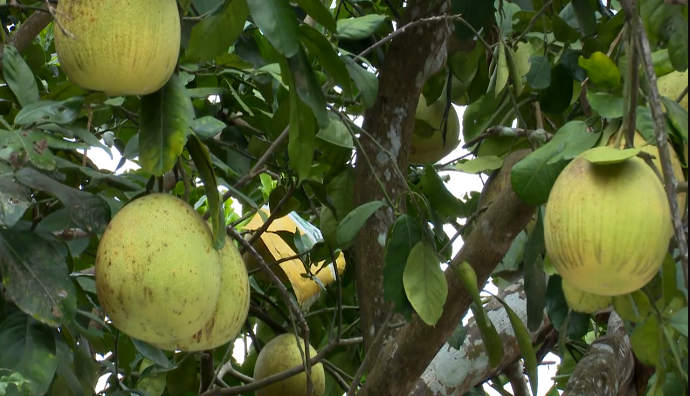Thanh tra in the village of Thuy Bieu. Photo: Ngoc Ha
This is the fifth time. I think, with the thanh tra festival in the early autumn, Hue people are making a "promise" not to let tourism in the old capital go cold after each Festival. Instead, it will be Hue with festivals all year round, calculated according to the cycle of the season and more, of the month. The theme of this year's festival is simply "Thanh tra – a disctinctive taste of Hue".
Thanh tra is just a kind of pomelo. Across our country, there are varieties of well-known pomelos, such as Doan Hung, Phuc Trach (in the north), or Bien Hoa pink pomelo, Nam Roi (in the south) ... But pomelos transformed into thanh tra are only available in Hue.
There is an old saying:
"How far away is Nguyet Bieu from Luong Quan,
Separated by a lagoon into two villages".
These two villages make up Thuy Bieu, which back then was a commune but now has become a ward. Some people explain that “Thuy” means water and “Bieu” is a gourd. So, Thuy Bieu means a water-holding gourd. Water from the Perfume River pours in, depositing sediment. The essence of the river is crystallized in the thanh tra.
There have been many descriptions of the taste of this fruit, which have intrigued me more than its name. Thanh tra contains everything, including the gentle sweetness and the bold flavours; green on the outside and pale succulent yellow on the inside; crispy and juicy when eaten, a little bit sour but without bitterness like other kinds of pomelos.
I have attended several thanh tra festivals. It is not as imposing with many delicious and strange fruits and many exciting accompanying cultural activities and organized in the street as the Southern Fruit Festival or the Dragon Fruit Festival of Binh Thuan. The Thanh tra festival is held in Nguyet Bieu, which is the cradle of thanh tra. The aim of coming to the festival is to enjoy this delicious fruit, so it is not strange that the highlights of the festival are the exhibitions, performances, contests and especially the “thanh tra offering” ceremony. Moreover, I understand, behind showcasing thanh tra fruit, the festival is an invitation to visitors to the land of this strange pomelo.
Hundreds of years passed but the miracle is that Nguyet Bieu - Luong Quan still embody almost the same representation of a poetic rural village in the time when the Nguyen Lords expanded their land to the south or when the ancient Phu Xuan Capital was in its golden era. The gardens are neat. The peaceful houses stay amidst the green orchards. Spring comes with a beautiful white color from the pomelo blossoms.
When autumn comes, the thanh tra fruits become laden, swaying and swinging. Some people dream, supposedly, that one day, the banks of Huong River will become Nguyet Bieu - Luong Quan, so that when spring comes, the banks of the Perfume River will become “white like snow” with thanh tra blossoms.
Following the scent of thanh tra, I once went straight to Bau Ho Cave, a mountain range in a continuous line with Vong Canh hill and separated by a valley. Bau Ho Cave reminds me of the high point Lang Biang in Dalat or The Peak in Hong Kong where I have had the opportunity to visit. These are the places that are attracting so many tourists who want to see Da Lat or Hong Kong from above. And higher than Vong Canh, standing on Bau Ho Cave, one can look out to Thuan An beach, to Tam Giang Lagoon and even out to the sea.
Across the river is the blue ‘Long’ Lake (Dragon Lake) and ‘Ngoc’ Lake (Pearl Lake). Flickering behind the mist is Hon Chen (Bowl island), Thien Mu pagoda and even the Citadel and Truong Tien Bridge, too. Mount Kim Phung is visible in all directions, and further, at the farthest corner is the magnificent Truong Son Range. This is the true view of Hue.
Coming to the thanh tra festival is not only an opportunity to enjoy the fruit, but it is also a chance to discover the hidden beauty of Nguyet Bieu - Luong Quan, a hidden beauty that only exists in the rich land and culture of Thua Thien Hue.
By Dan Duy

